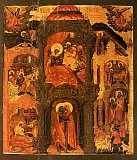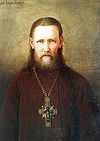

| Previous day | Next day |
| Old Style
September 8
|
Wednesday |
New Style
September 21
|
| 14th Week after Pentecost. Tone 4. | Fish, wine and oil allowed.
|
![]() The Nativity of Our Most Holy Lady the Theotokos and Ever-Virgin Mary.
The Nativity of Our Most Holy Lady the Theotokos and Ever-Virgin Mary.
Sts. Ioane (Maisuradze), archimandrite (1957), and Giorgi- Ioane (Mkheidze), schema-archimandrite (1962), confessors, of Georgia. St. Serapion, monk of Spaso-Eleazar Monastery (Pskov) (1481). St. Lucian, abbot, of Alexandrov (1654).
New Martyr Alexander Jacobson, at Solovki (1930).
Icons of the Most Holy Theotokos: Syamsk (1524), Glinsk (16th c.), Lukianov (16th c.), and Isaakov (1659). Icons of the Most Holy Theotokos: “Kursk Root” (1295), Pochaev (1559), Domnitsk (1696), Kholmsk (1st c.), and Lesna (1696).
St. Ina, King of Wessex, and his wife Queen Ethelburga (8th c.). New Martyr Athanasius of Thessalonica (1774). St. Sophronius of Achtalea in Georgia, bishop (1803).
Repose of Archbishop Dionysius of Ufa (1896), Elder Daniel of Katounakia, Mt. Athos (1929), and Priest Dimitrie Bejan of Romania (1995).







